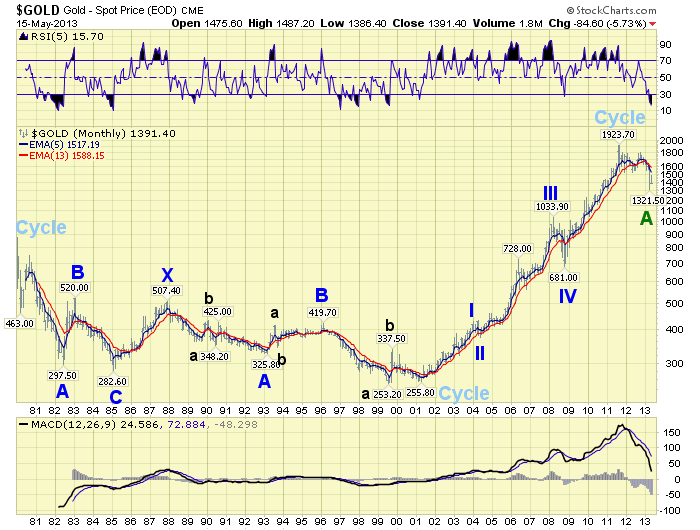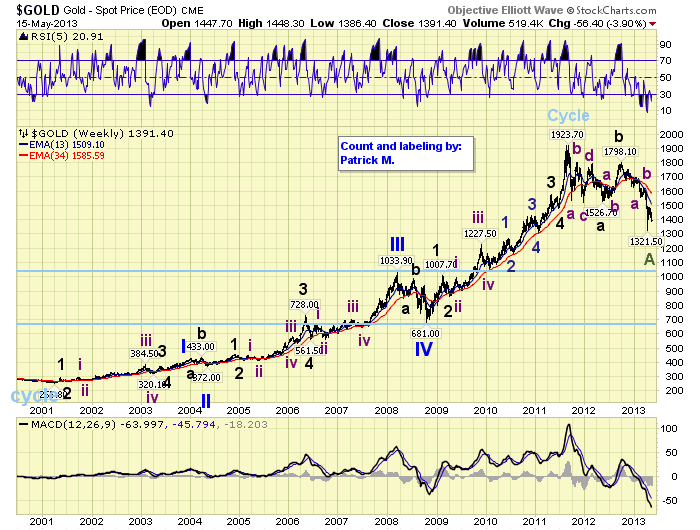We have written about the commodity market over the years, and have been generally bearish for quite some time. The typical commodity bull market lasts about 13 years, followed by about a 21 year bear market. This is the 34-year cycle. Commodity bull markets usually begin near the beginning of stock market Secular inflation/deflation cycles. Then end just before these cycles end. During the stock market Secular growth cycles commodities remain in a longer term bear market.
Some historical examples:
1929-1949 Secular deflationary cycle … commodity bull market 1933-1946.
1966-1982 Secular inflationary cycle … commodity bull market 1968-1980.
2000-2016? Secular deflationary cycle … commodity bull market 1999-2011.
In years past, the CRB index was used to determine the overall trend of commodities. In recent years this has been replaced by the world consumption oriented GTX index. Notice the bull market in the GTX started in 1999, but ended in 2008. Other sectors within this index--there are five--started/ended at different times. The barometer we use to determine the beginning/end of the commodity bull/bear markets is Gold.
As you can observe from the above chart, the consumption bull market started in 1999, completed five waves up into 2008, and the long term trend has been down since 2008. Keep in mind the GTX is about 70% weighted in Energy.
Other sectors, such as Industrial metals, Agriculture, and Precious metals started about the same time but topped in 2011. Livestock, the fifth sector, recently peaked in 2013.
Now that commodities are in a longer term bear market, this is what lies ahead for this asset class. The best example of a commodity bear market is the historical price activity in the CRB index. Notice the sharp decline from the 1980 peak was an ABC down, which lasted about 6 years. Then the index went into a trading range for the next 15 years before the next Cyclical bull market began.
When we review the historical chart of Gold, using the same time period, we observe a slight difference in time, but the same general pattern. Gold declined sharply, in an ABC pattern, for 5 years. Then entered a trading range for the next 14 years, before it put in that double bottom in 1999-2001.
If we dissect the 1980 bear market in Gold, we observe a two year decline of about $575 to form Primary A. Then a one year $225 rally for Primary B. This is followed by another two year decline. But this time it is only $240, to a slightly lower low, to form Primary C.
When we compare this activity to the current market, we find the bull market peak in 2011. Then a $600 two year decline that may have formed Primary A. If this comparison is correct, Gold should rally back to around $1545 by early next year to complete Primary B. Then the next two year Primary C decline should begin.
Keep in mind, commodities in general are quite volatile. Gold, in fact, has started to trade like Crude since it entered a bear market. One, two, three percent swings are possible in a single day.
The last chart of note is Natural Gas. While we do not have much historical data we already notice a pattern. Nat Gas bottomed in 1992, then went into a choppy 13 year bull market until it had a blow off peak in 2005. Since that peak it has had a lengthy 7 year ABC decline into 2012. This fits with Gold’s 5 year ABC, and the CRB’s 6 year ABC in the 1980′s bear market.
This comparison would suggest Nat Gas is now in an X wave rally, which starts the trading range of its longer term bear market. Therefore, just under $2.00 would be the base price for decades to come. This chart also suggests Nat Gas will likely be the first commodity to end its bear market. Possibly as much as 6 to 8 years ahead of the other commodities. With lots of supply coming on line in the next few years. An earlier bottom in Nat Gas would fit quite nicely with the demand/economic growth curve of the expected stock market Cycle wave [3]: approximately 2016-2034. The pieces, if we dare look that far out, seem to fit.
- English (UK)
- English (India)
- English (Canada)
- English (Australia)
- English (South Africa)
- English (Philippines)
- English (Nigeria)
- Deutsch
- Español (España)
- Español (México)
- Français
- Italiano
- Nederlands
- Português (Portugal)
- Polski
- Português (Brasil)
- Русский
- Türkçe
- العربية
- Ελληνικά
- Svenska
- Suomi
- עברית
- 日本語
- 한국어
- 简体中文
- 繁體中文
- Bahasa Indonesia
- Bahasa Melayu
- ไทย
- Tiếng Việt
- हिंदी
Using Gold To Gauge The Commodity Bear Market
Published 05/19/2013, 07:34 AM
Updated 07/09/2023, 06:31 AM
Using Gold To Gauge The Commodity Bear Market
3rd party Ad. Not an offer or recommendation by Investing.com. See disclosure here or
remove ads
.
Latest comments
Install Our App
Risk Disclosure: Trading in financial instruments and/or cryptocurrencies involves high risks including the risk of losing some, or all, of your investment amount, and may not be suitable for all investors. Prices of cryptocurrencies are extremely volatile and may be affected by external factors such as financial, regulatory or political events. Trading on margin increases the financial risks.
Before deciding to trade in financial instrument or cryptocurrencies you should be fully informed of the risks and costs associated with trading the financial markets, carefully consider your investment objectives, level of experience, and risk appetite, and seek professional advice where needed.
Fusion Media would like to remind you that the data contained in this website is not necessarily real-time nor accurate. The data and prices on the website are not necessarily provided by any market or exchange, but may be provided by market makers, and so prices may not be accurate and may differ from the actual price at any given market, meaning prices are indicative and not appropriate for trading purposes. Fusion Media and any provider of the data contained in this website will not accept liability for any loss or damage as a result of your trading, or your reliance on the information contained within this website.
It is prohibited to use, store, reproduce, display, modify, transmit or distribute the data contained in this website without the explicit prior written permission of Fusion Media and/or the data provider. All intellectual property rights are reserved by the providers and/or the exchange providing the data contained in this website.
Fusion Media may be compensated by the advertisers that appear on the website, based on your interaction with the advertisements or advertisers.
Before deciding to trade in financial instrument or cryptocurrencies you should be fully informed of the risks and costs associated with trading the financial markets, carefully consider your investment objectives, level of experience, and risk appetite, and seek professional advice where needed.
Fusion Media would like to remind you that the data contained in this website is not necessarily real-time nor accurate. The data and prices on the website are not necessarily provided by any market or exchange, but may be provided by market makers, and so prices may not be accurate and may differ from the actual price at any given market, meaning prices are indicative and not appropriate for trading purposes. Fusion Media and any provider of the data contained in this website will not accept liability for any loss or damage as a result of your trading, or your reliance on the information contained within this website.
It is prohibited to use, store, reproduce, display, modify, transmit or distribute the data contained in this website without the explicit prior written permission of Fusion Media and/or the data provider. All intellectual property rights are reserved by the providers and/or the exchange providing the data contained in this website.
Fusion Media may be compensated by the advertisers that appear on the website, based on your interaction with the advertisements or advertisers.
© 2007-2024 - Fusion Media Limited. All Rights Reserved.